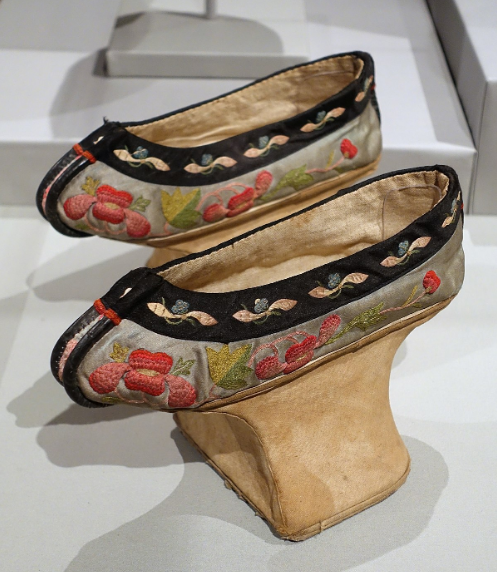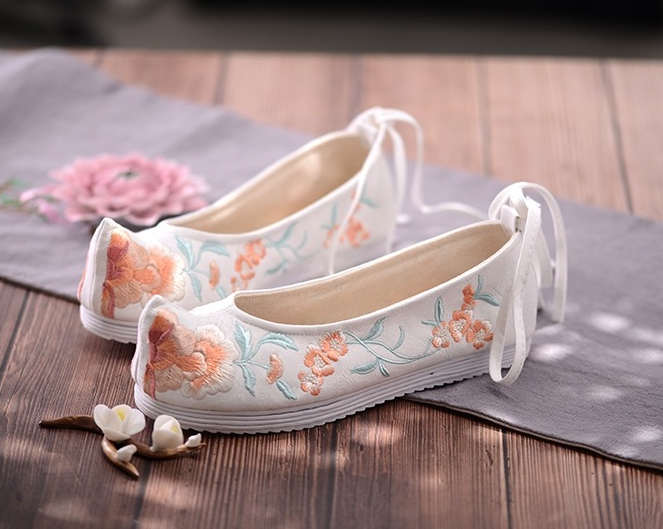Hanfu shoes are made of various materials such as leather (from tanbark and pelt), cloth (silk, hemp, damask, brocade, crepe), and straw (from cattail leaves, corn leaves, kudzu), along with wooden clogs.
Hanfu Shoes Materials
Hanfu shoes, traditional Chinese footwear, typically feature a blend of materials that reflect the rich cultural heritage and skilled craftsmanship of ancient China. These shoes often utilize natural fabrics and leathers, embellished with various decorative elements to create both functional and aesthetically pleasing designs.
Traditional Fabrics Used
In the realm of traditional fabrics, artisans commonly select silk, cotton, and brocade for their Hanfu shoes. Silk, known for its smooth texture and sheen, adds an element of luxury and is often preferred for formal or ceremonial shoes. Cotton, valued for its comfort and breathability, becomes the material of choice for everyday wear. Brocade, a more intricate and decorative fabric, features embroidered patterns that embody traditional Chinese motifs. These fabrics not only provide comfort and durability but also play a crucial role in showcasing the cultural significance of the footwear.

Common Leather Types
Leather plays a pivotal role in the durability and structure of Hanfu shoes. Artisans frequently use pigskin and cowhide, prized for their strength and flexibility. Pigskin, with its fine grain and soft texture, offers a comfortable fit and is often used for the shoe’s interior lining. Cowhide, known for its robustness, forms the outer structure, providing essential support and longevity. This combination ensures that Hanfu shoes can withstand daily wear while maintaining their traditional elegance.
Decorative Elements and Accessories
The beauty of Hanfu shoes often lies in their decorative details. Artisans adorn these shoes with various elements such as embroidered patterns, beads, and metal fastenings. Embroidery, an integral part of Chinese textile art, often depicts symbolic motifs like dragons, phoenixes, or floral designs, each carrying a specific cultural significance. Beads and sequins add a touch of sparkle and are meticulously hand-sewn onto the shoes, reflecting the artisan’s attention to detail. Metal fastenings, such as buckles and clasps, not only serve a functional purpose but also enhance the shoe’s aesthetic appeal. These decorative elements transform Hanfu shoes into a fusion of art and footwear, embodying the rich heritage of Chinese culture.
Manufacturing Process of Hanfu Shoes
The manufacturing process of Hanfu shoes is a meticulous and artistic endeavor, deeply rooted in traditional Chinese craftsmanship. This process involves several stages, each requiring precision and skill, to ensure the creation of shoes that are not only aesthetically pleasing but also comfortable and durable.
Cutting and Shaping Techniques
The first step in making Hanfu shoes involves cutting and shaping the materials. Artisans carefully select fabrics and leathers, laying them out to minimize waste. They then use traditional patterns to mark the material before cutting. The shaping process is crucial as it defines the shoe’s final form. Skilled craftsmen meticulously shape the leather and fabric to conform to the foot’s contours, ensuring a perfect fit.
Sewing and Assembly Methods
- Preparation of Components: Before assembly, craftsmen prepare each component of the shoe. They cut soles from durable leather and shape the upper parts from chosen fabrics.
- Stitching Upper Parts: Using sturdy threads, they stitch the upper parts, paying attention to seams for added strength and aesthetic appeal.
- Attaching Soles: The soles then get attached to the upper parts. This process often involves hand-stitching for precision.
- Reinforcing Key Areas: Areas prone to wear, like the heel and toe, receive extra reinforcement to enhance durability.
Finishing Touches and Quality Control
After assembling the shoe, craftsmen add finishing touches. This includes attaching decorative elements like beads or embroidery. Following this, each shoe undergoes a rigorous quality control process. Craftsmen inspect for any flaws in stitching, alignment, or decoration. They also check the fit and comfort level, ensuring each pair of Hanfu shoes meets high standards of quality and craftsmanship. This meticulous attention to detail in every step of the manufacturing process reflects the profound respect for traditional methods and the commitment to preserving the cultural heritage embedded in Hanfu shoes.
Historical Evolution of Hanfu Shoe Materials
The history of Hanfu shoe materials is a fascinating journey through time, reflecting the cultural, technological, and artistic developments of each era in Chinese history. This evolution showcases not only changes in materials and techniques but also the influence of social and trade dynamics on this traditional footwear.
Ancient Materials and Techniques
In ancient times, Hanfu shoes primarily used natural materials like animal hides, silk, and cotton. Craftsmen employed rudimentary tools to cut and shape these materials, relying heavily on hand-sewing techniques. The simplicity of these early shoes mirrored the limited resources and technological capabilities of the time. They often featured soft soles and minimal decoration, focusing more on functionality than aesthetic appeal.
Changes in Materials Over Dynasties
| Dynasty | Materials Used | Notable Changes |
|---|---|---|
| Shang Dynasty | Leather, Hemp | Introduction of leather for durability |
| Zhou Dynasty | Silk, Embroidery | Silk became popular, introducing embroidered shoes |
| Han Dynasty | Lacquered Wood, Cloth | Use of lacquered wood for soles, cloth for uppers |
| Tang Dynasty | Cotton, Brocade | Increased use of cotton, luxurious brocade for the elite |
| Song Dynasty | Padded Shoes | Introduction of padded shoes for warmth and comfort |
| Ming Dynasty | Rubber, Imported Fabrics | Introduction of rubber soles, use of imported fabrics |
| Qing Dynasty | Western Influences | Western styles and materials began influencing shoe design |
Influence of Cultural and Trade Exchanges
As trade routes expanded and cultural exchanges flourished, Hanfu shoe materials and designs saw significant changes. During the Silk Road era, new materials like precious stones and metals started appearing in shoe decorations. The Mongol invasion brought Central Asian influences, introducing boots and thicker soles for practicality. The arrival of European traders in the Ming and Qing dynasties introduced new materials like rubber and velvet, leading to a fusion of Eastern and Western design elements in shoe craftsmanship. These exchanges significantly enriched the diversity and quality of materials used in Hanfu shoes, turning them into a symbol of cultural amalgamation and artistic innovation.

Modern Adaptations and Sustainability
In the modern era, the evolution of Hanfu shoes continues, embracing contemporary innovations and sustainable practices. These adaptations are crucial in preserving the tradition while meeting the demands of today’s environmentally conscious society.
Contemporary Material Innovations
Manufacturers and artisans of Hanfu shoes are now experimenting with new materials to enhance comfort, durability, and aesthetic appeal. For instance, synthetic fabrics that mimic the properties of silk and brocade are being used, offering a similar look but with increased durability and less environmental impact. Memory foam insoles are another innovation, providing better support and comfort. Additionally, modern waterproofing techniques are applied to traditional fabrics, enhancing the functionality of the shoes without compromising their traditional appearance.
Eco-friendly and Sustainable Practices
Sustainability is now a key focus in the production of Hanfu shoes. Manufacturers are increasingly using eco-friendly materials, such as organic cotton and recycled fabrics, reducing the environmental footprint. Biodegradable packaging and the use of non-toxic dyes are other significant steps toward sustainability. Additionally, many artisans are adopting zero-waste production methods, ensuring that every piece of material is utilized efficiently, thereby minimizing waste.
Balancing Tradition with Modern Needs
Balancing the rich heritage of Hanfu shoes with modern requirements is a delicate task. Designers are incorporating traditional patterns and styles into shoes that suit contemporary lifestyles. For instance, the integration of ergonomic designs helps in making traditional shoes more suitable for prolonged wear. Also, the adaptation of Hanfu shoes for a variety of occasions, from formal events to casual wear, ensures that these traditional shoes remain relevant and appealing in the modern fashion world. This balance ensures that Hanfu shoes continue to be a symbol of Chinese culture while evolving to meet the needs of today’s consumers.